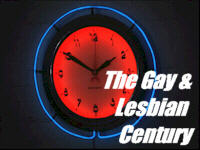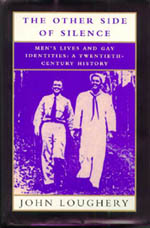 |

 |
|
|
| By Jesse Monteagudo
 As 1999 rolls along, we will encounter many attempts to review and
define the almost-concluded Twentieth Century. Time magazine has already
gotten into the act, with a series of "special issues" that list the people
and events that marked this awful and amazing century.
As 1999 rolls along, we will encounter many attempts to review and
define the almost-concluded Twentieth Century. Time magazine has already
gotten into the act, with a series of "special issues" that list the people
and events that marked this awful and amazing century.
TV programs on ABC and The History Channel, and books like The American Century, The Russian Century and The Century of Women, have tried to define the years since 1900 as ones of ferment for their particular countries, peoples or groups. With that in mind, I will go out on a limb somewhat and label the Twentieth Century of the Christian Era "The Gay and Lesbian Century". Not since Imperial Rome has one century brought about so many changes in the lives of lesbian women, gay men, bisexual and transgender people.
"Normal men" could and did have sex with "fairies" and retain their "normal" status just as long as they retained their masculine demeanor and played the "manly" role in sex. (This is still true in many Latin and Arab cultures.) Only after 1900 did homosexuality --and heterosexuality-- became rigidly defined categories based on sexual orientation. However you might define them, same-sex oriented women and men in 1900-1901 lived in a world that was vastly different than the one their spiritual descendants enjoy 99 years later. In 1900 Oscar Wilde died, an exile in Paris. His 1895 conviction for "gross indecency between males" led to a backlash in Britain against men-loving men. It also, as historian Alan Sinfield pointed out in The Wilde Century, irrevocably linked same-sex behavior with effeminacy in the public mind. Before Wilde, men like him were "aesthetes"; after Wilde they were "homosexuals." Indeed, it was around this time that the term "homosexual", first coined by the Hungarian Karoly Maria Kertbeny in 1868, became commonly used to describe same-sex oriented men (and women). It was also around this time (1900-1901) that same-sex behavior - long a "sin" and a "crime"--became a sickness. In 1900 Dr. William Lee Howard wrote an essay, "Effeminate Men and Masculine Women" (excerpted in Jonathan Ned Katz's Gay/Lesbian Almanac), that typifies the medical profession's new-found crusade against sexual nonconformity.
In 1901 Claude Hartland wrote The Story of a Life, the earliest autobiography of an avowed American homosexual. In a previous age, Hartland might have written his memoir as the "confessions" of a repented "sinner." This time Hartland wrote his book "for the consideration of the Medical Fraternity" who now had a whole new group of "sick" individuals to "cure". It was the heyday of the "third sex" theory of homosexuality, a concept shared by the medical profession and by early activists Karl Heinrich Ulrichs and Magnus Hirschfeld. (Hirschfeld had just published the first issue of his Jahrbuch der sexuelle Zwischenstufen or Journal of Sexual Intermediaries.) "In the following chapters," wrote Hartland, "appears the history of a being who has the beard and the well-developed sexual organs of a man, but who is, from almost every other point of view, a woman. . . . In this little volume he offers to the medical world the strange story of his own life, hoping that it may be a means by which other similar sufferers may be reached and relieved." This was a challenge that the medical profession was eager to accept. Other events of 1900-1901 show in retrospect how far our communities have come during the past 99 years. In 1901 the death of New York politician Murray Hall revealed that Hall was a woman who lived for many years as a man. Though Hall was not the last biological female to live as a man (jazz musician Billy Tipton would do so until "his" death in 1989), "passing women" increasingly became a thing of the past as our century rolled along. Also passe were the sexless "Boston marriages" of the Victorian Era: sex between women, which Queen Victoria (d. 1901) thought inconceivable, became a definite possibility to a new generation of Twentieth-Century women. Still, the years 1900-1901 saw the first stirrings of what would later become a world-wide lesbian and gay liberation movement. The same Magnus Hirschfeld who pushed the theory of "sexual intermediaries" also condemned the "degeneracy" theory of homosexuality propagated by Richard von Krafft-Ebing. His countryman Adolf Brand went even further, celebrating "male culture, art, and literature" in his journal rDer Eigene (The Self-Owner). Still another German, Elisar von Kupffer, published in 1900 Freundesliche (Comrade Love), a ground-breaking anthology of writings about men-loving men. The following year the Austrian Aimee Duc published Sind Eis Frauen? (Are These Women?), a positive depiction of lesbian love. Though the German and Austrian homosexual rights movements were annihilated by Adolf Hitler's storm troopers in the 1930's, they paved the way for similar movements throughout Western Europe and North America. Just last year German activists paid Hirschfeld the ultimate compliment by resurrecting his Wissenschaftlich-humanitares Komitee (Scientific-Humanitarian Committee). The Twentieth Century was to see great setbacks for lesbian, gay, bisexual and transgender people - the "purity" crusades of the 1930's; the Nazi, Soviet and Maoist persecutions; the McCarthyite witch hunts; AIDS. But these setbacks were more than compensated by the great strides our people made during the last century, primarily the emergence of generations of increasingly "out and proud" women and men. Though queer life today has its share of perils and problems, it is a vast improvement over that lived 100, 50, 25 or even 10 years ago. Barring an unforeseen catastrophe – a virulent new strain of AIDS or a government controlled by the Christian Coalition - the Twenty-First Century promises to bring even more progress. Menu Photo: Activist Franklin Kameny, Actress Ellen DeGeneres, AIDS Memorial Ribbon, murdered openly-gay San Francisco City Councilman Harvey Milk |

© 1997-99 BEI
 John Loughery's The Other Side of Silence traces gay history through the 20th Century
John Loughery's The Other Side of Silence traces gay history through the 20th Century